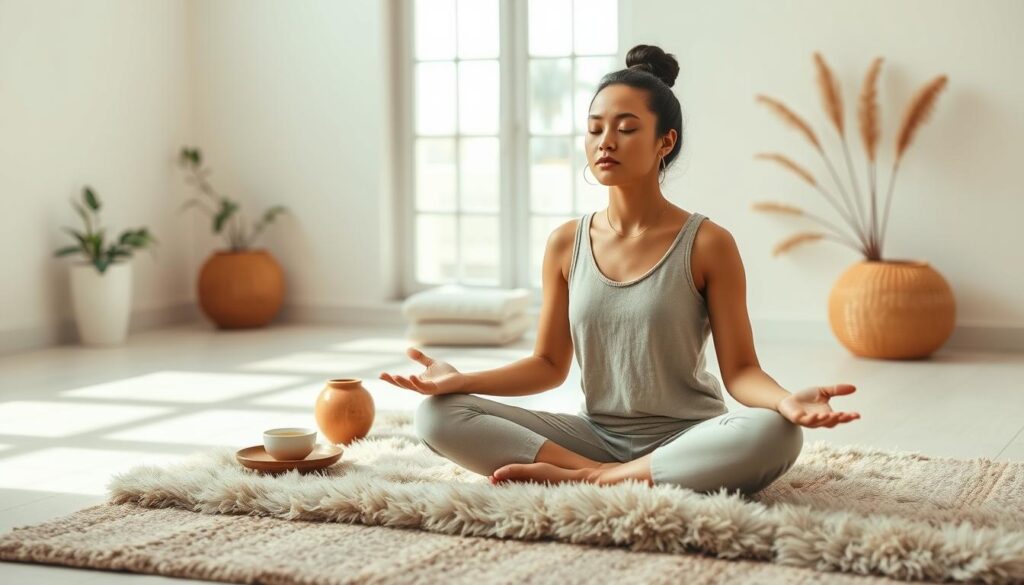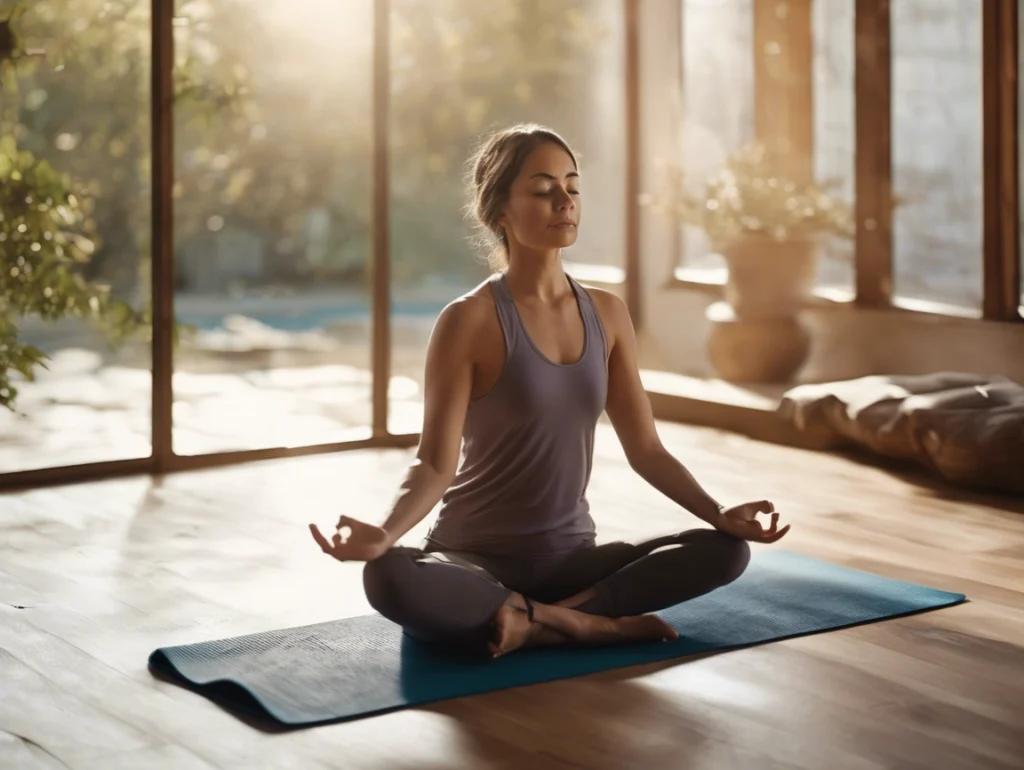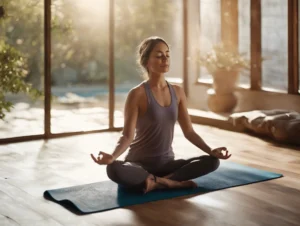Can you find calm in chaos? Navigating a busy season can be tough. It’s easy to lose sight of what brings peace.
Practicing mindfulness can help. It’s a strong way to fight stress and overwhelm. By adding mindful moments to your day, you can stay calm and clear, even when life is busy.
Seeking a more intentional life means embracing mindful living. It’s not just a practice; it’s a way to live more fully. We encourage you to explore mindfulness and share it with others who might find it helpful.
Understanding Mindfulness and Its Benefits
Mindfulness is a powerful tool for finding balance and peace in our busy lives. It’s a practice that’s gaining attention for its many benefits. Let’s explore what mindfulness is and how it can improve our lives.
Definition of Mindfulness
Mindfulness means being fully present in the moment. It’s about noticing your thoughts, feelings, and body sensations without judgment. This practice helps you respond to life’s challenges more thoughtfully.
The Science Behind Mindfulness
Studies show that mindfulness can greatly improve our mental and physical health. It changes the brain, helping with attention, emotions, and memory. This leads to better thinking and feeling better overall.
- Mindfulness reduces stress and anxiety by calming us down and lowering stress hormones.
- It helps us manage our emotions better, making it easier to handle tough situations.
- Regular mindfulness practice also improves sleep, which is key for our health.
Mental Health Benefits of Mindfulness
Mindfulness offers many mental health benefits. It can lessen anxiety and depression, improve mood, and boost overall mental health. It also helps us understand ourselves better, including our values and goals.
To start practicing mindfulness, try simple activities like focusing on your breath or walking mindfully. As you get more comfortable, you can try more advanced techniques and make mindfulness a part of your daily life.
If this article inspired you, share it with someone who might need a boost today. For more mindful living tips and inspiring content, subscribe to the Lumina Hive Magazine. Let’s create a life that feels good, inside and out, together.
Common Misconceptions About Mindfulness
Many of us have wrong ideas about mindfulness. It’s not hard or mysterious. It’s a simple way to be more aware and calm every day.
Mindfulness is more than just a buzzword. It’s a tool that can change our lives. By clearing up common myths, we can use it to its fullest.
Mindfulness is Not Just Meditation
Many think mindfulness means only meditation. But, mindfulness is about being fully present in any activity. This includes eating, walking, or even working.
- Mindfulness can be practiced during daily activities like cooking or showering.
- It involves paying attention to our thoughts, feelings, and bodily sensations without judgment.
- Mindfulness can be cultivated through formal meditation practice, but it’s not the only way to do so.
The Myth of a “Perfect” Practice
Another myth is that there’s a “right” or “wrong” way to practice mindfulness. The truth is, there’s no one-size-fits-all approach to mindfulness. What matters most is being aware and compassionate in our daily lives.
Some key points to remember:
- The goal of mindfulness isn’t to achieve a specific state or stop our thoughts completely.
- It’s okay if our minds wander; the practice is in gently bringing our attention back to the present moment.
- Mindfulness is a journey, not a destination; it’s about progress, not perfection.
If this article resonated with you, don’t keep it to yourself; share it with someone who could use a little inspiration today. Want more mindful living tips, fresh ideas, and soulful reads? Subscribe to the Lumina Hive Magazine and stay in the buzz. Together, we’ll keep creating a life that feels good, inside and out.
Creating a Mindful Environment
The place you live in can help or hurt your mindfulness practice. It’s key to make a space that encourages calm and clear thinking.
Our surroundings greatly affect our mood. A messy place can make us feel stressed. But a tidy, peaceful area helps us relax and focus better.
Declutter Your Space
Getting rid of things you don’t need is important for a calm space. Start by cleaning one area at a time. Sort items into three piles: keep, donate, and throw away.
| Area | Clutter | Solution |
|---|---|---|
| Living Room | Piles of magazines, remote controls | Organize magazines, designate a spot for remotes |
| Kitchen | Cluttered countertops, kitchen gadgets | Clear countertops, store gadgets in drawers |
Jon Kabat-Zinn, a mindfulness expert, said, “You can’t stop the waves, but you can learn to surf.”
“You can’t stop the waves, but you can learn to surf.”
This quote shows how important it is to accept our surroundings and find peace in them.
Incorporate Natural Elements
Adding natural things to your space can make it feel calmer and more connected to nature. Think about adding plants, using natural materials for decor, or bringing in wood or stone.
- Add plants like snake plants or peace lilies for a touch of greenery
- Use natural materials like wood or bamboo for furniture and decor
- Incorporate elements like river rocks or seashells into your decor
By cleaning up your space and adding natural elements, you can make a place that supports your well-being. Remember, the space around you is key to staying present and focused as you practice mindfulness.
If this article helped you, share it with someone who might need it. For more mindful living tips and inspiration, subscribe to the Lumina Hive Magazine. Let’s create a life that feels good, inside and out, together.
Mindfulness Techniques for Everyday Life

You can live more mindfully by adding simple yet powerful techniques to your daily life. Mindfulness means being fully present in the moment. There are many ways to do this every day.
Breath Awareness
Breath awareness is a simple yet effective mindfulness technique. It helps calm your mind and brings you to the present. To practice, find a quiet spot, sit comfortably, and focus on your breath.
When your mind drifts, gently bring it back to your breath. Start with short sessions, even just a few minutes a day. Gradually increase the time as you get more comfortable.
Mindful Eating
Mindful eating can change how you see food. It’s about fully experiencing eating and drinking, both physically and emotionally. To practice, eat slowly, savor each bite, and notice the flavors, textures, and smells of your food.
Eating mindfully helps you enjoy meals more and have a healthier relationship with food.
Walking Meditation
Walking meditation combines physical movement with mindfulness. To practice, walk in a quiet place, either indoors or outdoors. Focus on the feeling of your feet on the ground, the movement of your legs, and your breath’s rhythm.
As you walk, stay present, letting go of distractions. Focus on the experience of walking.
If this article inspired you, share it with someone who might need it today. For more mindful living tips, fresh ideas, and soulful reads, subscribe to the Lumina Hive Magazine. Let’s create a life that feels good, inside and out, together.
Integrating Mindfulness into a Busy Schedule
Busy schedules don’t have to stop you from practicing mindfulness. They can actually help you find calm and clarity. By using simple techniques, you can make mindfulness a part of your daily life.
Mindful Mornings
Starting your day with mindfulness can set a positive tone. Begin with a morning routine that includes deep breathing, meditation, or noticing your body’s sensations. Adding mindful movement like yoga or tai chi can also help.
Short Mindfulness Breaks Throughout the Day
Short breaks throughout the day can keep you grounded. Spend a few minutes focusing on your breath or noticing your surroundings. Even simple actions like sipping tea mindfully or taking a short walk can be beneficial.
| Practice | Duration | Benefit |
|---|---|---|
| Deep Breathing | 2-5 minutes | Reduces stress and anxiety |
| Mindful Walking | 5-10 minutes | Improves focus and clarity |
| Body Scan | 5 minutes | Relaxes the body and mind |
Adding mindfulness to your busy schedule can improve your well-being. Start small and be consistent. As you make mindfulness a habit, you’ll find it helps you stay balanced and focused.
If this article inspired you, share it with someone who might need it. For more mindful living tips and ideas, subscribe to the Lumina Hive Magazine. Let’s create a life that feels good, inside and out, together.
Mindfulness for Different Life Stages
Whether you’re a student, parent, or senior, mindfulness can help. It supports your well-being at every stage of life. Our challenges change, but mindfulness remains a constant help.
Mindfulness for Students
Students can use mindfulness to handle stress and stay focused. It improves concentration and mental clarity. This leads to better grades.
Simple practices like breath awareness or mindful walking are great. They help during study times or before exams.
Mindfulness for Parents
Parents face many challenges, making mindfulness very helpful. It keeps them calm and patient, even when things get tough. Techniques like mindful listening can strengthen family bonds and lower stress.
By practicing mindfulness daily, parents can feel refreshed. They can then engage more fully with their families.
Mindfulness for Seniors
For seniors, mindfulness is a way to reflect and find peace. It helps with age-related issues like pain or memory loss. Simple exercises, like focusing on the breath, can be adapted for any physical ability.
These practices promote calm and well-being.
If this article inspired you, share it with someone who needs it. For more mindful living tips and inspiration, subscribe to the Lumina Hive Magazine. Let’s create a life that feels good, inside and out.
Using Technology to Support Mindfulness
In today’s fast world, technology can help a lot with mindfulness. It can guide you to live more mindfully and intentionally. Digital tools offer support and help.
Mindfulness apps are a great way to start your day right. They have guided meditations, tracking, and reminders. They help you stay focused and mindful.
Mindfulness Apps to Consider
Many mindfulness apps are popular and easy to use. Headspace and Calm are well-known for their guided meditations. They cater to all levels of experience.
When picking an app, think about what you need. Do you want guided meditations or a timer? Some apps also track your mood and offer personalized advice.
Guided Meditations Online
Online guided meditations are also great for mindfulness. Sites like UCLA Mindful and Mindful.org have many free meditations. They help with stress and focus.
Remember, being consistent and patient is key. “The mind is everything; what you think, you become,” Buddha said.
“The mind is everything; what you think, you become.”
Using technology for mindfulness helps you stay on track. It brings many benefits to your life.
If this article helped you, share it with someone who needs inspiration. For more mindful living tips and ideas, subscribe to the Lumina Hive Magazine. Let’s create a life that feels good, inside and out.
Cultivating a Mindfulness Community
Starting your mindfulness journey can be easier with a supportive community. Being part of a group gives you a sense of belonging. It also helps you stay committed to your mindfulness practice.
Supportive Networks
Joining a support group is a great way to meet others who care about mindfulness. These groups are safe places to talk about challenges and celebrate wins.
Mindful Connections
Having a mindfulness buddy is also helpful. You can share experiences and motivate each other. Look for local events or online forums to find your buddy.
If this article has inspired you, share it with someone who needs a boost today. For more tips on living mindfully, subscribe to the Lumina Hive Magazine. Together, we can create a life that feels good, inside and out. As the seasons change, try new routines like an autumn skincare routine to care for your body and mind.
FAQ
How do I transition my skincare routine for fall?
To transition your skincare routine for fall, consider switching to richer, more hydrating products. Adjust your routine according to your skin type.
What are the best products for hydrating skin in the fall?
For hydrating skin in the fall, look for products containing hyaluronic acid, ceramides, and niacinamide. These help lock in moisture and support the skin’s barrier function.
How can I protect my skin from dryness during the fall season?
To protect your skin from dryness, use a humidifier and apply moisturizer immediately after bathing. Avoid harsh products that strip the skin of its natural oils.
Are there any specific skincare trends I should follow for fall?
Some top fall skincare trends include using products with antioxidants, incorporating facial oils, and utilizing sheet masks for an intense dose of hydration.
How often should I exfoliate during the fall season?
Exfoliating once or twice a week is generally recommended during the fall season. It helps remove dead skin cells and improves moisturizer absorption.







